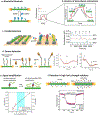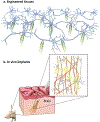Nanowire-Enabled Bioelectronics
- PMID: 36970717
- PMCID: PMC10038126
- DOI: 10.1016/j.nantod.2021.101135
Nanowire-Enabled Bioelectronics
Abstract
Bioelectronics explores the use of electronic devices for applications in signal transduction at their interfaces with biological systems. The miniaturization of the bioelectronic systems has enabled seamless integration at these interfaces and is providing new scientific and technological opportunities. In particular, nanowire-based devices can yield smaller sized and unique geometry detectors that are difficult to access with standard techniques, and thereby can provide advantages in sensitivity with reduced invasiveness. In this review, we focus on nanowire-enabled bioelectronics. First, we provide an overview of synthetic studies for designed growth of semiconductor nanowires of which structure and composition are controlled to enable key elements for bioelectronic devices. Second, we review nanowire field-effect transistor sensors for highly sensitive detection of biomolecules, their applications in diagnosis and drug discovery, and methods for sensitivity enhancement. We then turn to recent progress in nanowire-enabled studies of electrogenic cells, including cardiomyocytes and neurons. Representative advances in electrical recording using nanowire electronic devices for single cell measurements, cell network mapping, and three-dimensional recordings of synthetic and natural tissues, and in vivo brain mapping are highlighted. Finally, we overview the key challenges and opportunities of nanowires for fundamental research and translational applications.
Keywords: Bioelectronics; Biosensor; Brain mapping; Electrophysiology; Nanowire.
Conflict of interest statement
Declaration of interests The authors declare that they have no known competing financial interests or personal relationships that could have appeared to influence the work reported in this paper.
Figures




References
-
- Bresadola M, Brain Res. Bull, 46 (1998) 367. - PubMed
-
- Offenhäusser A, Rinaldi R, Nanobioelectronics-for Electronics, Biology, and Medicine, Springer, New York, 2009.
-
- Wang J, Chem. Rev, 108 (2008) 814. - PubMed
-
- Mulpuru SK, Madhavan M, McLeod CJ, Cha Y-M, Friedman PA, J. Am. Coll. Cardiol, 69 (2017) 189. - PubMed
Grants and funding
LinkOut - more resources
Full Text Sources
